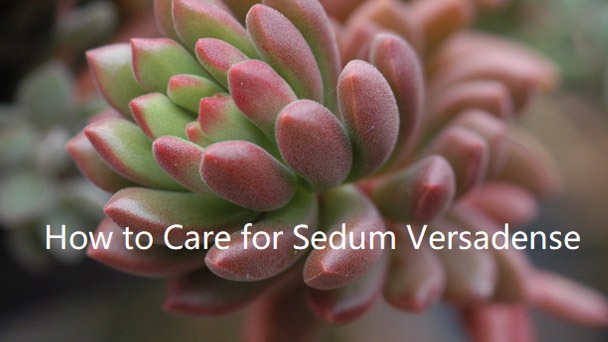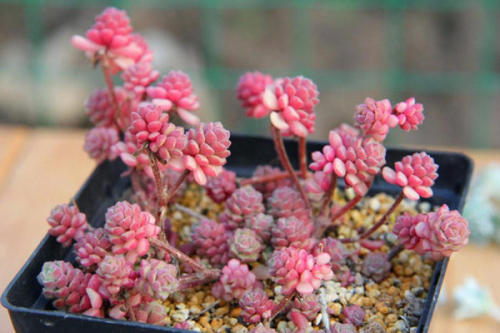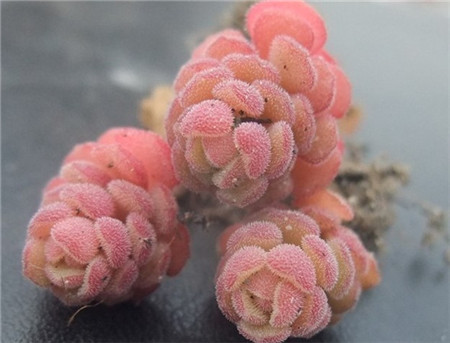How to Grow and Care for Sedum Versadense
Written by Maggie
Dec 28 2022

Sedum versadense is a succulent plant that usually blooms in the autumn. How to grow and care for Sedum versadense? Please look down together.
Sedum versadense is not highly resistant to heat or cold. And Sedum versadense is very drought-tolerant, so don't water it too often while it's growing, if you water too much it can rot the roots. Warm and enough light to make it have a better growth.
How to Care for Sedum Versadense
1. Temperature
Sedum versadense is not highly resistant to heat or cold, growing normally at temperatures between 20 and 25 degrees Celsius. When we grow and care for Sedum versadense, the temperature in the summer should be kept below 30 degrees, and the temperature in the winter should not be too low, otherwise you will get frostbite and you will not grow normally next year.
2. Watering
Sedum versadense is very drought-tolerant, so don't water it too often while it's growing, if you water too much it can rot the roots. When we grow and care for Sedum versadense, do not have water in the basin when watering each time, wait until the soil thoroughly dry and then watering, watering once in 20 days.
Sedum versadense grows in mild temperature in spring and fall, and cannot resist extreme cold. Growing it in a pot rather than directly in garden soil is preferable if you do not live in a warmer climate.
Sedum versadense may go dormant during the summer when the temperature rises above 30 °C. Wintertime: Bring it inside when it's below 5 °C to prevent fatal or irreversible frostbite. It requires a little water during its spring and fall growing seasons. Watering should be minimized during the dry seasons of summer and winter.
3. Light
Warm and enough light to make it have a better growth. Its color is more pink and lovely if it is in good light, and it needs about four hours of light a day to grow properly. When we grow and care for Sedum versadense, summer bright light needs to be avoided, winter can receive normal light.
As a rule, sedum versadense requires bright, transparent, scattered light. Without sufficient sunlight, a plant will eventually become spindly, its tissue will deteriorate slowly, and its color will gradually deteriorate. The plant's resistance to disease weakens, its shape sags, and it turns green and yellow.
Its leaves and stems could be damaged by the intense summer sun. It usually grows slowly or not at all when exposed to the sun. Shorter stems and compact leaf growth make the plant shorter. Old leaves on some succulent plants wither in the summer, and new leaves typically have a short, compact appearance with a bare rod shape. In the summer, place a sunshade or bring the potted plant inside.

4. Fertilization
Sedum versadense does not need fertilization, and it can grow very well without fertilization. When we grow and care for Sedum versadense, if you want to fertilize it, it is best to choose succulent fertilizer and not to fertilize it.
5. Soil
Sedum versadense grows best in loose, well-ventilated soil. The soil is typically broken down into three layers. The top deco layer, middle planting layer, and bottom hydrophobic layer are all ordered from top to bottom. Every one needs a different kind of soil.
To decorate and fix plants, the top deco soil is laid down on the soil's surface. Some people can guard against illness and pest insects. It should be watered once it is completely dry. Various types of soil, including white pebble, akadama soil, kiryuu sands, kanuma soil, etc., can be used as top deco soil. Select it based on the particular pots and plants.
Plants are held in place by the middle layer of soil, which also supplies them with nutrients. You can purchase soil to mix your own soil or purchase planting soil for succulents from a store. Peat moss: perlite: volcanic rock: vermiculite = 4:2:2:2 is a typical soil composition for this layer.
The soil of the lower hydrophobic layer is placed at the bottom of the flowerpot or garden hole to evacuate the excess water in the succulent root system and prevent the root system from rotting due to water accumulation. Ceramsite, volcanic stone, or other large-scale culture media can be used to create the hydrophobic layer. Charcoal or coal slag are also suitable options. Make sure the bottom drainage layer has good water permeability if it is to be planted in a garden.
How to Plant Sedum Versadense
When planting, add a thin layer of planting layer soil to the flowerpot before adding the hydrophobic layer. The roots were then positioned by being spread out. Planting soil should be applied slowly over the root. Then add the top decorative layer and once more water. To plant in the garden, first dig a pit that is 1.5–2 times the size of the root system. Then, proceed as described above.
It needs to be repotted if the roots are too dense or unhealthily established, in order to help it grow better and more quickly. Repot in the spring and the fall. Before repotting, stop watering a few days in advance. You can gently knock the pot outside once the soil has dried. To separate the soil from the pot, you can also use a knife. Then, proceed as directed above after gently lifting the plant a little bit to help it emerge from the pot.
Though you can plant different colors of succulent plants together, avoid planting succulent plants with different growth habits together. While others don't, some succulents require water in the summer. If they are planted together, one may get sick from overwatering while the other may wilt from not getting enough.
How to Trim Sedum Versadense
Sedum Versasense is small and doesn't need much trimming. When we grow and care for Sedum versadense, just trim off yellow leaves or old branches. Over-pruning makes it hard to recover.
Large succulent plants may require pruning to maintain a lovely shape. For example, for echeveria planted in the garden, redundant branches or branches that are too dense need to be cut off in spring and fall. this depends on the plant's purpose and your preference. Knives, scissors, and some drugs (such as sulfur powder) make up the majority of the pruning equipment.
In the spring and fall, trim a few leaves to help new plants grow. Pick a stem with 5–6 leaves that is sturdy. It can be removed with a knife, covered in sulfur powder until the wound is healed, and then planted. Planting soil should be given a light mist.
Sedum Versadense Propagation Methods
Succulents can be multiplied in numerous ways. Although seeds can be gathered for sowing, they are difficult to germinate. For cutting propagation, leaves are more frequently used, typically in the spring and fall. With the leaf base close to the soil, choose a whole leaf from a healthy plant, cut it off with a knife, and lay it flat on the soil. Give it the right amount of light (bright, scattered light) and heat (25 °C). At the base of the leaf, a bud will appear in a week or two.
- Read More: How to Propagate Sedum Versadense
Seasonal Precautions
There are several ways to guarantee ventilation in the summer. ① use loose soil; ② use a ceramic pot with good air permeability; ③ keep potted plants in multi-ventilated environments.
Avoid harsh summer light. Move indoors any potted plants and provide shade for any plants outside. Additionally, keep plants out of direct sunlight after watering to prevent burning.
Thick-leaved varieties easily dehydrate in heat due to the high water content in their leaves. By reducing their water supply earlier, plants can enter dormancy more smoothly and avoid damage from summer heat.
Diseases and Pests Control
- Disease: Anthrax causes the leaves and branches of the plant to turn yellow and wilt, which can be controlled by spraying wetted powder.
- Insect pests: aphids will appear. When we grow and care for Sedum versadense, we can use pesticides or dilute insecticides to spray.

Succulents can become infected with deadly black rot, sooty mold, powdery mildew, and other diseases thanks to soil bacteria that flourish in high temperatures and humidity. Sterilize the soil one month before summer. Carbendazim should typically be diluted in water at a ratio of 1:000. Apply it evenly to the stems and leaves.
Root-filling is a treatment option for the underground components. Sterile liquid should be submerged in the flowerpot while you wait for the soil to gradually absorb it. Carbamazepine should be administered twice, separated by two weeks. It is simple to spritz sterilization liquid directly on succulent plants or to irrigate the soil with a small amount of sterilization liquid.
The succulent needs to be isolated as soon as early disease symptoms are discovered. Cut off the diseased part and smear the wound with sulfur powder or carbendazim to avoid secondary infection. Spray water and carbendazim then evenly over the entire plant. It's better to cut the plant off and discard it if the entire thing is already black and rotten and the leaves are translucent.
Pests are another significant issue with succulent plants. Verify that the soil and succulents you purchase are pest-free before buying. Aphids, scale insects, spider mites, white butterflies, and other common pests are listed below. In the summer, pests frequently appear. Succulent pests can typically be controlled.
Use water to wash the plant or hand-pick the pests if there are only a few. Apply succulent plant pesticide to larger outbreaks and areas where pests are hiding (like leaf crevices).
Both imidacloprid and avermectin are efficient. When using them, make sure the concentration is appropriate and that you follow the instructions on the package. It's simple to kill the succulent if the concentration is too high. On areas where there are pests, pesticide should be applied carefully. As a precaution, spray pesticide on areas where there are no pests.
Pesticides should typically be applied in the evening in a ventilated area. Use only once every two weeks. After the initial application, if there isn't any obvious pest recurrence, there's no need to apply again.
Change the soil if pests are hiding in it. Remove the pest-filled soil, carefully separate the root system, and then add fresh soil. If you don't want to change the soil, soak the bottom of the flowerpot in liquid pesticide for one to two minutes, or until the soil has absorbed enough pesticide through the holes in the bottom of the flowerpot.
The presence of a sizable ant colony is another thing you might observe where scale insects congregate. Ants consume the nectar secreted by scale insects, and they also aid in the scale insects' migration to other plants, which is mutually beneficial. this may explain why the outbreak of scale insects is so widespread and so fast. A close-by ant infestation should be eradicated.
Common Problems of Sedum Versadense
Why Do My Plant's Leaves Turn Yellow and Wither?
The fading and yellowing of leaves is a normal occurrence. Don't panic. If new buds turn yellow and withered, it is abnormal, and may be caused by lack of some mineral fertilizer or by sunburn.Why Do Its Leaves Wrinkle?
Water shortage is typically to blame for wrinkled leaves. Wrinkled or shriveled leaves are a warning sign that a succulent needs water.Why Does It Have a Very Tall Stem But Few Leaves?
Lack of light can result in a weak, tall stem, fewer leaves, and more delicate plant tissue, which makes the plant more vulnerable to harm. The succulent will gradually get better with time if you place it in a well-lit area.
Why Does My Sedum Versadense Have Black Rot?
The most fatal disease for succulent plants is black rot. The plant initially develops a black, rotten area. Finally, the entire plant turns black and rotten and the leaves start to fall off when touched. Black rot is most likely to occur in humid summer months when the soil is poorly drained and overly wet. The same procedure as before is used for treatment.
Latest Updated
- Benefits of Bugleweed - 7 Science-backed Health Benefits
- Bugleweed Dangers & Side Effects - Is It Poisonous?
- How to Plant Evergreen Trees - What You Should Know
- When to Plant Evergreens - Grow Guide for Evergreen Trees
- 12 Wonderful Evergreen Shrubs for Your Garden
- 12 Popular Evergreen Plants with Pictures for Beginners
- When And How To Prune A Lilac Bush Like a Pro
- How to Grow & Care for Lilac Vine (Hardenbergia Violacea)
- Japanese Lilac Tree (Syringa Reticulata) Care & Propagation Guide
- Shumard Oak Pros and Cons - What to Know
Popular Articles
- Winter maintenance of Antirrhinum Majus
- How to Grow Terminalia Mantaly Tree
- How to Grow and Care for Crossostephium Chinense
- How to grow Antirrhinum Majus in spring
- Peristeria Elata (Dove Orchid) Profile: Info & Care Guide
- Underwatered Snake Plant (Sansevieria Trifasciata) - Signs And How To Fix
- How to Care for Brazilian Jasmine Plant (Mandevilla Sanderi)
- How to Grow & Care for Graptopetalum Purple Delight in Summer
- Rosa Chinensis (China Rose): Plant Growing & Care Tips
- How to Care for Baby Sun Rose (Aptenia Cordifolia)